When learning Python programming language, you’ll find some concepts confusing at first. With time and practice, you’ll realize that the concepts are there to simplify the representation of complicated concepts.
One common aspect of Python that may be confusing is the concept of returning a value of -1.
In Python, a return value of -1 indicates that a specific item or value was not found or that an operation has failed. In other words, it tells you about the result of an operation in Python. For example, in the context of searching operations in certain data structures such as lists or strings, a return value of -1 typically signifies that the sought-after item doesn’t exist in the data structure.

You’ll often come across a -1 return value when working with strings or functions. This article will teach you how to interpret and utilize the -1 return value. We’ll look at what -1 means in Python and how you should interpret it in certain scenarios.
Let’s get into it!
Reviewing the Basics
Before we take a closer look at the -1 return value, let’s review some preliminary knowledge. This will help you build a solid understanding of interpreting the -1 return value.
We’ll look at 2 important concepts that go hand-in-hand with the -1 return value:
- Return Statement
- Function Call
1. What is a Return Statement?
A Python return statement is an explicit return statement that’s used inside a function object or method to send the function’s result back to the caller.
The following is an example of a return statement in Python:
def subtract(a, b):
result = a - b
return result
print(subtract(5,4))The output is given below:
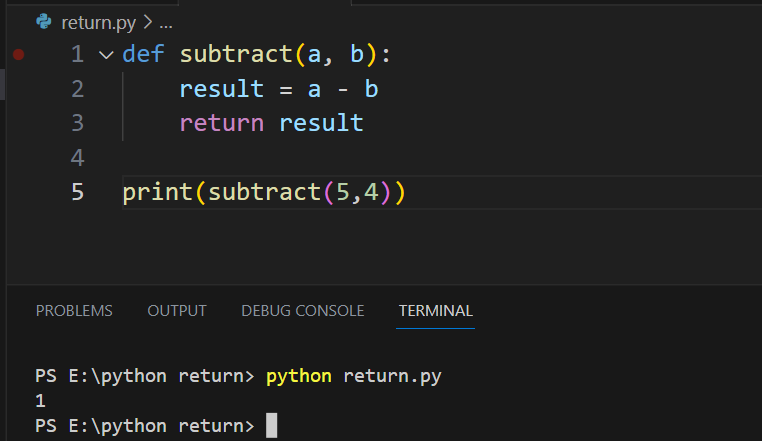
In this example, we use the explicit return statement to ask the function to return the result of subtraction b from a. The function returns 1 as the final value.
The return result in a return statement in this example.
2. What is a Function Call?
As the name suggests, a function call is an invoke statement to a particular function.
In the subtraction example above, the subtract(5,4) is a function call.
Now that we’ve reviewed the basics, let’s understand the -1 return value in Python.
What is -1 Return Value?
As we saw in the example above, a function or method returns a particular value. If the return value from a function is -1, it holds a special meaning in Python — it usually denotes an error or indicates that something was not found.
It’s crucial to note that this is not a built-in mechanism in Python, but a convention followed by developers. Thus, the meaning of a -1 return value will depend on the specific context and Python documentation of the function or method being used.
In the next section, we’ll go over some examples of the -1 return value in action.
4 Examples of -1 Return Value
This section will review 4 examples of -1 return value to help you better understand the concept.
We’ll go over the following:
- -1 Return Value When Working with String and List Methods
- -1 Return Value When Working with Custom Division Functions
- -1 Return Value of a Binary Search
- -1 Return Value When Working with OS Functions
1. -1 Return Value When Working with String and List Methods
In Python’s string and list methods like find(), index(), etc., -1 means that the substring or element was not found.
The following example demonstrates this scenario:
s = 'hello'
print(s.find('z'))The output of the above code block will be:
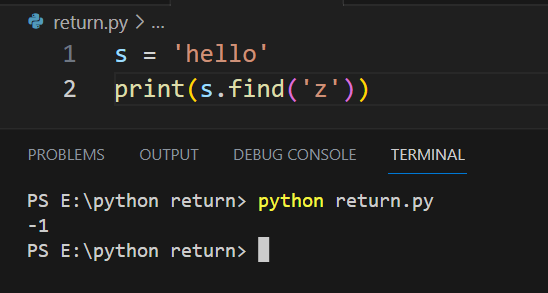
The -1 return value indicates that the letter z was not found in the string hello. This is an implicit return statement, and the Python interpreter returns -1 without our specification.
2. -1 Return Value When Working with Custom Division Functions
This is a case of -1 return value where you can utilize it to your benefit. You can designate a custom function to return -1 when trying to divide by zero.
The following example demonstrates this use case:
def safe_divide(a, b):
if b == 0:
return -1
return a / b
print(safe_divide(10, 0))The output of the above example will be:
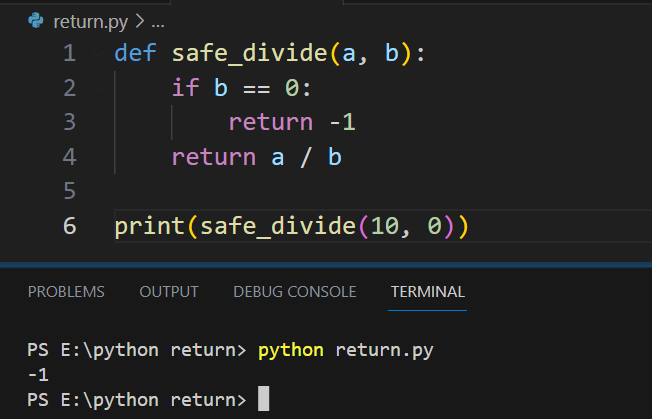
The return statement consists -1 to indicate that such a division is not possible. This is an explicit return value because we specifically told the compiler to return -1.
3. -1 Return Value of a Binary Search
A binary search function will return -1 when the target element is not found in a sorted list.
The following code demonstrates this use case:
def binary_search(lst, target):
left, right = 0, len(lst) - 1
while left <= right:
mid = (left + right) // 2
if lst[mid] == target:
return mid
elif lst[mid] < target:
left = mid + 1
else:
right = mid - 1
return -1 # target not found
print(binary_search([1, 2, 3, 4, 5], 10)) # prints: -1The binary_search function implements the binary search algorithm on a sorted list (lst), looking for a specified value (target).
The function divides the list in half, repeatedly eliminating the half where the target cannot be until it either finds the target (returning its index) or exhausts all possibilities (It will return a value of -1 to indicate the target was not found).
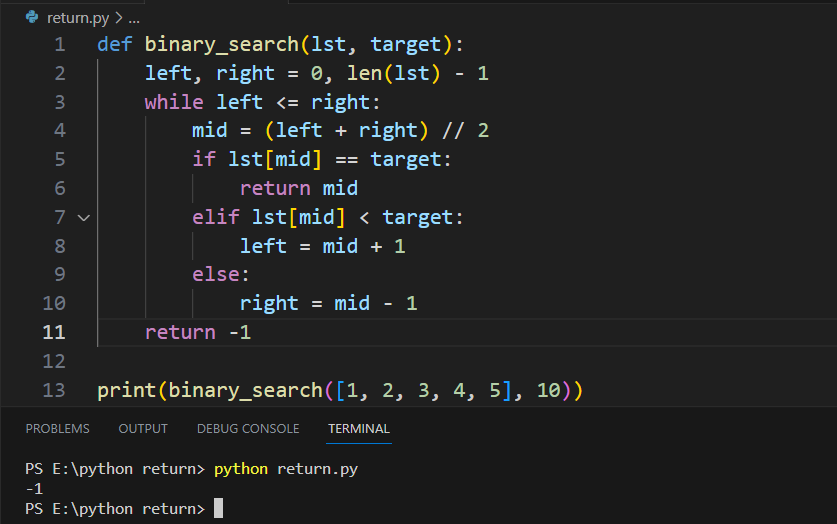
4. -1 Return Value When Working with OS Functions
Most often, when working with functions that are close to your operating system, a -1 return value will signal the failure of execution.
The following example demonstrates how Python’s os module can return -1 to signal an error when interacting with the operating system.
import os
def get_parent_process_id(pid):
try:
parent_pid = os.ppid() # gets parent process id
return parent_pid
except:
return -1
print(get_parent_process_id(999999)) # for non-existent PID, it should return -1In this example, we’re trying to get the parent process id of a process id that doesn’t exist.
When an error occurs in os.ppid(), our function catches it and gives back the optional return value -1 to signal the error.
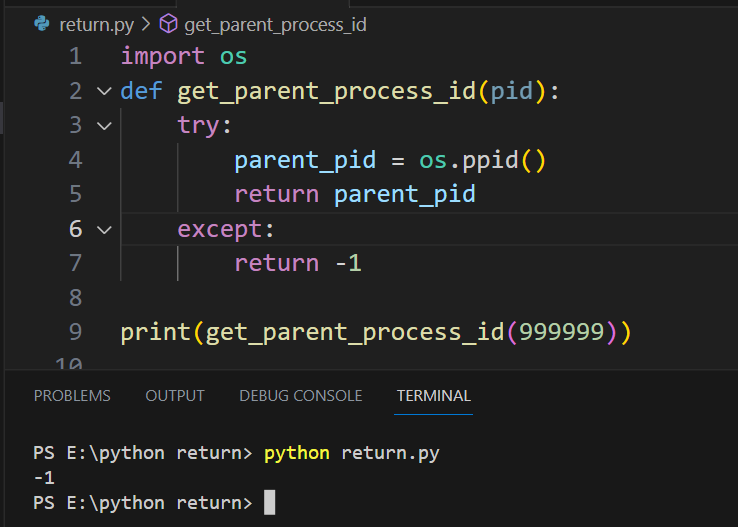
This was a simulated scenario, but in practice, the -1 return value is more common in system calls or other low-level operations.
If you’d like to learn more about functions in Python, check out the following video:
Final Thoughts
Understanding the meaning and significance of a -1 return value in Python is invaluable for your coding journey. It’s a universal signal for errors, non-existence, or specific outcomes in many built-in and user-defined functions.
Learning to interpret -1 return values helps you debug programs more efficiently, ensuring your code works effectively. It allows your functions to provide meaningful feedback, guiding users and fellow developers alike.
As you delve further into Python, you’ll encounter scenarios where you may need to return multiple values from a function, and understanding conventions like returning -1 for error conditions or not found situations can help you manage these complex scenarios more effectively. Happy coding!
Frequently Asked Questions

What is the role of return -1 in error handling?
In Python, return statements like “return -1″ are often used as sentinel values to indicate an error or an exceptional condition in a function. By returning -1, a function provides a way for the caller to identify that something went wrong during the function’s execution, and then handle that situation accordingly.
When should I use return -1 in Python functions?
You should consider using return -1 in a Python function when you want to signal an error or an exceptional condition that cannot be represented using standard return values.
In what scenarios is return -1 applicable?
Return -1 is applicable in scenarios where a function needs to indicate an error or an exceptional condition.
For example, you might use return -1 in a function that searches for a specific element in a list, to indicate that the element is not found.
How does return -1 differ from return 0 in Python?
In Python, return -1 and return 0 have different meanings and implications.
A function returning -1 usually indicates an error or exceptional condition, while a function returning 0 typically denotes successful execution or a standard output.
Can return -1 be used in debugging or testing Python code?
Yes, return -1 can be useful while debugging or testing Python objects. By using return -1 to signal error conditions, you can write test cases to verify that your functions handle these conditions properly.
Additionally, during debugging, you can track down issues more effectively by checking for functions that return -1.








